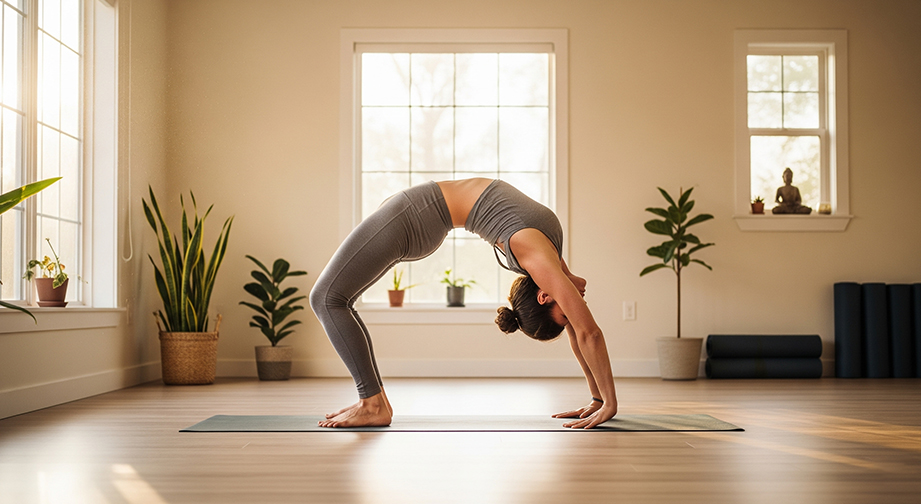Urdhva Dhanurasana / Chakrasana (Upwards-Facing Bow, Wheel Pose): Step-by-Step Guide
Introduction
Urdhva Dhanurasana, also called Chakrasana, is known in English as the Upwards-Facing Bow or Wheel Pose. In this powerful inversion, the entire body forms a graceful arch—like a wheel—lifting your heart and energy skywards.
In Sanskrit, Urdhva means "upward," Dhanura means "bow," and Asana means "pose." The essence of this pose: energizing and heart-opening.
If you ever feel stiff after sitting too long or crave a burst of energy, Urdhva Dhanurasana can be your best friend—opening the front body and leaving you feeling expansive and alive!
Step-by-Step Guide: Urdhva Dhanurasana (Wheel Pose)

- Lie flat on your back, feet hip-width apart, knees bent, and soles on the floor.
- Bend your elbows and place your palms on the floor beside your head, fingertips pointing towards your shoulders.
- Anchor your feet and hands. Press firmly into both.
- Inhale — Press into your hands and feet, lifting your hips and chest off the mat.
- Continue inhaling — Straighten your arms gradually, pushing your chest up and bringing your head off the ground.
- Hold —Keep breathing steadily, lifting through your heart. Stay for 3–5 breaths (or up to 30 seconds).
- To release, exhale and slowly bend your arms and legs, lowering yourself gently back onto your mat.
- Rounds: 1–3 rounds, resting between attempts.
- Beginner modifications: Place yoga blocks under your hands, or practice raising just the hips (Bridge Pose).
- For intensity: Walk the feet closer to the hands, or lift one leg off the ground at a time for an extra challenge.
Alignment & Safety Tips
- Key cues: Knees point forward (don’t splay), feet and hands press evenly, keep shoulders broad, hips lifting strongly.
- Common mistakes: Feet and knees turning outward (keep parallel), dumping weight into low back (engage core), elbows flaring (keep them aligned).
- Safety: Avoid if pregnant, have wrist/shoulder/neck injuries, recent back surgery, or uncontrolled high blood pressure.
Benefits of Urdhva Dhanurasana (Wheel Pose)
Physical Benefits
- Strengthens arms, shoulders, legs, and spine
- Boosts flexibility in the chest, hip flexors, and back
- Improves posture and spinal mobility
- Stimulates thyroid and pituitary glands
Mental Benefits
- Relieves stress and fatigue
- Energizes and uplifts mood
- Promotes mental clarity and resilience
Energy & Chakra Connection
- Opens the heart (Anahata Chakra) for self-love and compassion
- Invigorates the entire energetic system
Contraindications
- Pregnancy
- Recent or chronic injuries to shoulders, wrists, back, or neck
- Uncontrolled blood pressure or heart conditions
Safe alternatives: Try Bridge Pose (Setu Bandhasana) or Supported Fish Pose for a gentle heart opener.
Beginner’s Tips & Variations
- Props: Use blocks under your hands or a rolled blanket under the shoulders for support.
- Gentle variation: Practice Bridge Pose or lift up just halfway into a supported backbend.
- For advanced practitioners: Try one-legged Wheel Pose (Eka Pada Urdhva Dhanurasana) or dropbacks from standing.
How to Include in a Yoga Flow
- Best as a main practice when your body is fully warmed up
- Pairs well with:
- Bridge Pose (Setu Bandhasana) for preparation
- Camel Pose (Ustrasana) for further heart-opening
- Supine Twist for a gentle cool-down
Mind-Body Connection
In Urdhva Dhanurasana, focus on your breath and the spaces your heart and lungs create. Stay present and aware—this heart-opening posture also opens pathways to courage and joy.
Spiritual tip: This pose is closely tied to the Anahata (Heart) Chakra—inviting compassion, acceptance, and positive energy.
Summary Box
- Asana Name: Upwards-Facing Bow (Wheel Pose) / Urdhva Dhanurasana / Chakrasana
- Level: Intermediate to Advanced
- Focus Areas: Spine, chest, arms, shoulders, legs
- Duration: 3–5 breaths (up to 30 seconds); 1–3 rounds
- Best Time to Practice: Morning or Daytime (when properly warmed up)
FAQs about Urdhva Dhanurasana (Wheel Pose)
Q: Can beginners safely try Urdhva Dhanurasana?
A: Yes, with proper warm-up and modifications (like using blocks or practicing Bridge Pose first). Listen to your body!
Q: How can I avoid wrist pain in Wheel Pose?
A: Always warm up wrists, press through all fingers evenly, and try elevating your hands on yoga blocks if needed.
Q: What should I focus on while in Wheel Pose?
A: Breath, chest lifting, knees and feet staying parallel, and a sense of openness through the heart and front body.